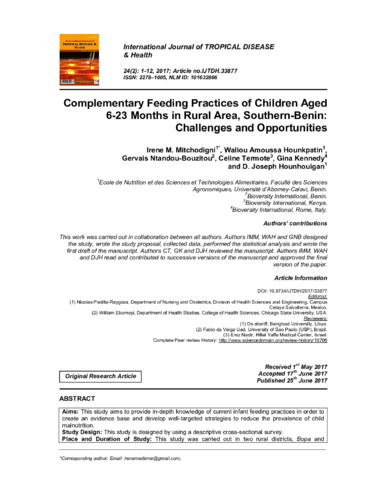Complementary feeding practices of children aged 6-23 months in rural area, Southern-Benin: challenges and opportunities
Aims: This study aims to provide in-depth knowledge of current infant feeding practices in order to create an evidence base and develop well-targeted strategies to reduce the prevalence of child malnutrition.
Study Design: This study is designed by using a descriptive cross-sectional survey.
Place and Duration of Study: This study was carried out in two rural districts, Bopa and Houeyogbe, in Southern Benin from October to December 2013.
Methodology: A total of 1225 mother-infant pairs, aged 6-23 months were randomly selected in seventeen villages through exhaustive sampling. Socio-demographic data of participants were obtained through semi-structured interviews. Complementary feeding practices were assessed using recommended Infant and Young Child Feeding (IYCF) indicators. Statistical analysis were performed with SPSS version 20. Statistical significance was set at P<0.05.
Results: Overall, 20% had timely initiation of complementary feeding, whereas 61% and 17% had early and delayed initiation of complementary feeding, respectively. The mean age of introducing solid foods was 4.9 ± 2.3 months. Prevalence of MDD, MMF and MAD was 60%, 71% and 46% respectively. There is no specific complementary foods (CFs) for Benin children. Cereal porridges and extracts from family diets were two categories of complementary foods identified. Complementary food (CF) is characterized by unenriched porridges, mashed family diets and low consumption of fruits and eggs. Most of the children (70%) were fed vegetables consumed individually or mixed with other leaves. The most popular vegetables consumed by the children were Corchorus olitorius (48%), Hibiscus esculentus (22%), Solanum macrocarpon (18%).
Conclusion: Untimely initiation of complementary feeding was predominant. Complementary feeding practices in this area of Benin were suboptimal. The valorization of local biodiversity and traditional recipes was an opportunity to improve quality of child’s diet. Reinforcing the capacity building of stakeholders focused on child feeding may be a crucial step for child well-being.

